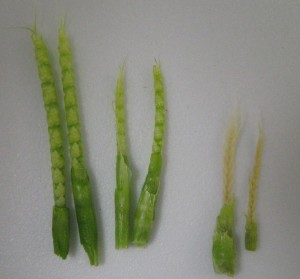by Dr. Calvin Trostle, Professor & Extension Agronomist, Lubbock, (806) 723-8432, ctrostle@ag.tamu.edu
Over the past several weeks light freezing conditions have occurred in north Texas, the northern Rolling Plains, and more pronounced freezes at the top of the Texas Panhandle. No reports yet have indicated strong injury other than a few fields in Lipscomb Co. Those fields were injured March 21, so injurious temperatures likely needed to be in the mid-20s or lower. As of March 29 some wheat was at second joint, and Lipscomb Co. ag. extension agent J.R. Sprague reports a few fields appeared to have up to 25% damage (dead growing points). Fields at the top of the Panhandle may again require further assessment this week due to temperatures dropping <20°F the last weekend of March.
Extension agronomist Dr. Emi Kimura reports some minor damage in the norther Rolling Plains including Knox Co., but little overall impact on the wheat crop.
AgriLife Extension staff have long noted that wheat freeze injury is usually never as bad as it looks. But it often takes a trained eye and helpful resources to ascertain what may have in fact occurred. Potential freeze damage on wheat is not always the same. The degree of freeze, its duration, stage of growth, warmth of the soil, and how well the canopy is developed are all factors in determining the extent of potential freeze damage. And unless you have obvious immediate foliage damage, it takes a week or so to identify the actual damage and death to growing points.
When I walk into a field a week or so after a freeze, one of the first things I look for is if the most recently emerged leaf is brown and dead (left stem, Fig. 1). If this is so, the growing point is dead, and there is no potential yield for that stem—and no need to look at that stem further. Later tillers can compensate for these dead growing points, so seeing some dead most recently emerged leaves only merits further investigation, which will then involve cutting other stems to find the head. If the head down inside the stem is brown, it is dead. If might even look pale and wilted (middle heads, Fig. 2) thus the stem should not be counted as contributing to yield.
Texas Resources for Freeze Injury Assessment
For resources to assess potential freeze damage on Texas small grains, consult http://wheatfreezeinjury.tamu.edu There you will find “Wheat Freeze Injury Assessment Resources,” which include our primary document for Texas, “Wheat Freeze Injury in Texas,” as well additional links to pointers, tips & tools, etc. for assessing wheat freeze injury. Many of these resources are supported by pictures of different growth stages of wheat with different types of injury.
If you need to assess possible freeze injury in wheat or other small grains but you have never done it before, most county ag. Extension agents have received training, or ask for help from a consultant, another farmer, your seed dealer. After assessing freeze injury in over a period of 20 years, I usually still learn something new every time we have another freeze, but fortunately assessing freeze injury has defined parameters to evaluate, and you can learn how to do it.

Calvin Trostle
Professor and Extension Specialist
Lubbock, TX
803.746.6101
ctrostle@tamu.edu

